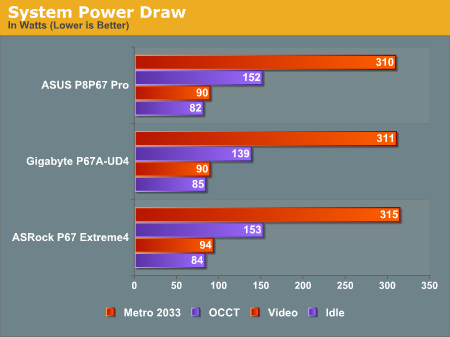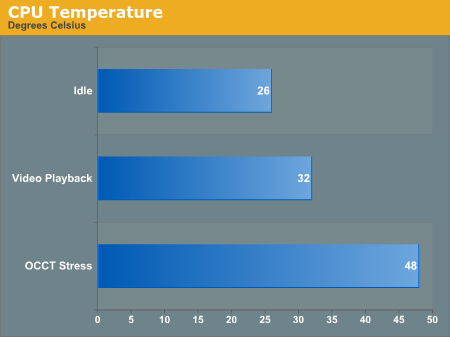Welcome to Sandy Bridge, with the ASRock P67 Extreme4
by Ian Cutress on January 3, 2011 7:00 AM EST- Posted in
- Motherboards
- ASRock
Overclocking
Overclocking on Sandy Bridge is significantly easier than on previous platforms. With only the multiplier to play with, it is a case of finding the correct balance of multiplier and voltage.
Using the AXTU software bundled with the motherboard, I simply pushed the multiplier up to 44x (4.4GHz) without any issues. At this speed, the CPU would declock to 4.0GHz when OCCT was running, indicating that we were hitting the power draw limit automatically determined by the motherboard. On 4.5GHz, the system would BSOD when starting the OCCT stress tool, indicating that not enough voltage was being supplied to the processor.
In the UEFI, due to the auto overclocking settings offered, I set the system to boot at 4.6GHz. In the OS, this set a voltage of 1.378V, and ran an OCCT stress test fine, showing a maximum temperature of 70ºC (Idle 37ºC). At the 4.8GHz setting, we got 1.49V through the processor, but a failed OCCT stress test. On the next boot, I had to reset the UEFI to get it to stay stable while changing settings.
In my wisdom, and by delving into the UEFI settings, I ventured forth to manipulate the multiplier and voltages personally. I booted into Win7 with 4.5GHz, 1.4V on VCore and 1.9V on CPU PLL (for some headroom), and turned off Load Line Calibration. However, the OCCT stress test also resulted in the CPU declocking automatically. In order to get this to stop, I had to turn on Intel SpeedStep, and increase the Long Duration Power Limit from 95W to 110W. With this, I hit 4.6GHz and 4.7GHz (hitting 73 ºC, and reducing to 4.6GHz so I increased the power to 120W). For 4.8GHz, I pushed VCore to 1.45V, and the power limits to 150W (short) and 130W (long)—this gave a stable OCCT at 80ºC but would randomly BSOD. At these settings, 4.9GHz would not boot into the OS, and I was not willing to push them further.
4.6GHz using the UEFI settings seems like the best bet for any user wanting a simple 24/7 overclock. The 3D Movement multithreaded benchmark rose from a stock score of 341.74 to 451.84.
Power Consumption and CPU Temperatures
Power consumption was tested on the system as a whole with a wall meter connected to the power supply, using a dual GPU configuration. This method allows us to compare the power management of the UEFI and the board to supply components with power under load, and includes typical PSU losses due to efficiency. These are the real world values that consumers may expect from a typical system (minus the monitor) using this motherboard.


The Extreme4 doesn't do too badly in power consumption readings compared to the other boards. It ends up slighly higher under heavy loads, but the differences are small enough that we can't see power requirements being a selling point one way or another yet.










55 Comments
View All Comments
chrnochime - Monday, January 3, 2011 - link
So basically for any CPU that has its multiplier locked, there's just no way to oc the CPU. Either pay up for an unlocked CPU or be content with stock speed. Hmm...wolfman3k5 - Monday, January 3, 2011 - link
I've read all the Sandy Bridge articles that you guys posted. And while at first glance it seems that you're really enthusiastic about the products, they are low end and mid range products. What I take from all the Sandy Bridge articles is that X58 high end platform is obsolete and that everyone should jump on the mediocre Sandy Bridge bandwagon. When I'm saying mediocre I'm not referring to the Core i5 2500K or to the Core i7 2600K CPUs. I'm referring to the rest of the platform and its limitations. No full support for SATA 6.0 (which AMD already had for months), only two 8X PCI-E lanes for high end SLI or CrossFire configurations, only dual channel memory. I mean, it is obvious that this is a new product and that Intel needs to sell it, but it doesn't mean that everyone who got a high end system on a X58 platform should throw it away. Also, the old X58 platform is far more modular. Yes, I know that X58 is old, and I hope that we'll see an update in the high end segment.But the question is: Do you guys ever get tired of advertising for Intel, or is the money just too good?
extide - Monday, January 3, 2011 - link
If you actually read all the articles like you said, you would see that they said that if you already have a high end x58/i7 system, then you should keep it. If you are considering BUYING a new system then they suggest getting SB over a p55 or x58 system.wolfman3k5 - Monday, January 3, 2011 - link
X58 has been around before LGA1156, and is still around. Sandy Bridge is meant to kill everything that runs on LGA1156, not X58. The platform that Sandy Bridge runs on will be obsolete in 6 months. PCI-E 3.0 is just around the corner. That's when LGA2011 will be released, the successor of LGA1366. Conclusion: It doesn't really matter if you buy X58/i7 or P67/SandyBridge, they'll be both obsolete.AssBall - Monday, January 3, 2011 - link
So you must never buy anything new, because in 6 months it will be obsolete. Just because there are new platforms doesn't mean the old ones are useless or no longer cost effective.I don't see where you get that "advertising for intel" junk from, either.
vol7ron - Monday, January 3, 2011 - link
Wolfman, if you read any of Anandtech's articles, you'd know they don't accept compensation for any of their reviews - while this has helped them out sometimes, it has also hurt them. They have to be careful to be non-biased, but also respectful of manufacturers. Downing a product too much means they won't get as many products to test in the future (and have to wait longer to buy it for the review), not being honest enough discredits the article in the reader's eyes - the fine line must be walked and words chosen delicately. Still, funding is from advertisement and donations.Your AMD points are valid, but still unimpressive in comparison. As they stated, AMD is a better option for the lower CPUs, since you can OC them, whereas Intel has locked the i3's.
I agree, USB3 needs adoption, they've had long enough. That said, Intel is still in domination and AMD has some work to do if they want to contend.
DanNeely - Monday, January 3, 2011 - link
The point of the reviews is that unless you need something that is only available on x58 (ie enough PCIe lanes for 3/4GPU setups, or 2 GPUs and a high end raid card) then there's next to no point in buying into the platform because a $300 2600k, is able to beat a $1000 hexcore in most benchmarks.I'm interested in LGA2011 too because a 30% faster quad core isn't overly exciting as an upgrade. My main concern is that with the 2600K running $300, that intel might demand $500+ for a hexcore that doesn't have crippled OC limits.
Etern205 - Monday, January 3, 2011 - link
The only people interested in PCIe 3.0 are the gamers and enthusiast. 99% of the average use won't give a thought about what they have and test shows PCIe 2.0 doesn't have that much of a improvement over PCIe 1.1 in terms of performance.LGA 2011 the successor to LGA 1366 is still call Sandy Bridge. Funny how your not interested in this "obsolete" hardware but excited about the one after which by your terms is still "obsolete". This is the first time I've seen a person excited about some outdated hardware which has yet gone out the door.
As for AMD, if they made a CPU that can out perform Intel, I'm sure this site and all other will be all over it like a celebrity meet with lights and flashes. Unfortunately, the last time AMD has that spot light was before Intel came up with the Conroe.
Hopefully, AMD's bulldozer will let them once again shine in the spot light.
tim851 - Tuesday, January 4, 2011 - link
99% of the average users are still happy with the Athlon X2s they bought in 2005...mapesdhs - Wednesday, January 5, 2011 - link
That's a good summary, unless of course one prefers to dabble with 'traditional'
overclocking and/or overall platform costs of P55/X58 are more attractive. There
are plenty of very well priced P55 boards available now. Hard to give a concrete
nod to SB without knowing the mbd costs.
Personally, my results reinforce your summary. Performance-wise, SB offers
nothing useful over what I already have. Different though perhaps for someone
who is running with an i3/i5 on a P55 board, but yet again it depends on the
application.
Ian.
PS. I've praising Asrock's PCIE slot spacing for months, very glad to see
they're sticking to it. Their P55 boards use the same setup. Perfect for
cooling SLI/CF setups and a lot better than most X58 boards.